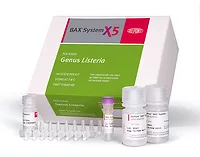Development of a Detection Method for Listeria spp. in Food and Environmental Samples on the Atlas™ System
Listeria is an environmentally ubiquitous organism implicated as a major cause of human foodborne illness worldwide. Its long lag phase and hindered growth in the presence of competitive flora presents a challenge for rapid and reliable detection in food and environmental samples with a single 24-hour enrichment step. The purpose of the study is to develop a sensitive and reliable detection method for Listeria with testing being performed after a single 24-hour enrichment for both food and environmental samples. The assay utilizes a high-throughput, fully automated, walk-away instrument, the Atlas System.
 Roka Protocol and Method Confirmation
Roka Protocol and Method Confirmation
The Roka Listeria Detection Assay was evaluated with nine food types: romaine lettuce, pasteurized whole milk, brie cheese, vanilla ice cream, hot dogs, deli chicken, chicken salad, cured ham and smoked salmon. Each food type was prepared with and without inoculation, and the assay results were compared to culture. Preparing a bulk inoculation with a Listeria spp., fractional positives with culture were desired for each food type. The food was stored at 4°C for 48-72 hours or –20°C for 2 weeks prior to inoculation of Half-Fraser broth. A 25-g sample of each food was added to the broth and incubated at 35°C for 24-28 hours, a 400-µL aliquot of enriched sample was added to the Roka Transfer Tube containing a lysis solution and the tube was loaded onto the Atlas System. Secondary enrichment in Fraser media and subsequent surface plating on Modified Oxford agar (MOX) or Oxford agar (OXA) was performed for culture confirmation.
Environmental samples from four different collaborators encompassing 15 different food plants and 14 different food types were tested with the Roka Listeria Detection Assay and compared to culture. Samples were collected from a variety of surface types with sponges or Spongesicles® in zones 1-4 and shipped overnight. Upon arrival, 190 mL Half-Fraser broth was added to the collection device. The environmental sample was then incubated at 35°C for 24-28 hours, 10-12 µL of enriched sample was added to the transfer tube containing a lysis solution and the sample was tested with the assay.
Selectivity was evaluated by testing 50 target microorganisms and 30 non-target microorganisms commonly found in food. Target microorganisms are grown at 35°C for 16-24 hr in Half-Fraser broth, colony counts determined from tryptic soy agar and samples prepared for testing 10 colony-forming units (CFU) for all species with the exception of Listeria grayi. For L. grayi, samples were prepared for testing at 1000 CFU. Non-target microorganisms were grown overnight at an appropriate temperature for each species (26°C, 30°C or 35°C), each was verified to be at a concentration equal to or greater than a 1 McFarland standard, and undiluted samples were tested with the assay.

 Results
Results
The Roka Listeria Detection Assay demonstrated 100 percent sensitivity compared to culture for all food types with the exception of smoked salmon (98.5%) and hot dogs (92.6%). Specificity with food compared to culture ranges from 82.1 percent for hot dogs inoculated with L. grayi to 100 percent for brie cheese, deli chicken, vanilla ice cream, pasteurized whole milk and smoked salmon (Table 1: Method Comparison Results with Food). For environmental samples, the assay demonstrated an overall sensitivity of 87.5 percent compared to culture with one assay false negative in zones 2 and 3 (Table 2: Method Comparison Results with Environmental Samples). Since the environmental samples came from the collaborator’s food plants, discrepant analysis was performed on the two assay false-negatives, which were confirmed negative by quantitative PCR for the Listeria iap gene. Overall specificity was determined to be 99.1 percent with  one assay false positive in zone 2, and four assay false positives in zone 3. All culture-positive samples were found in zones 3 and 4, with the exception of one in zone 2. For selectivity, the assay demonstrated 100 percent sensitivity with all 50 Listeria spp. at 10 CFU, including L. grayi at 1000 CFU (Table 3: Inclusivity: Organisms Detected), and 100 percent specificity for all non-target microorganisms commonly found in food (Table 4: Exclusivity: Organisms Not Detected).
one assay false positive in zone 2, and four assay false positives in zone 3. All culture-positive samples were found in zones 3 and 4, with the exception of one in zone 2. For selectivity, the assay demonstrated 100 percent sensitivity with all 50 Listeria spp. at 10 CFU, including L. grayi at 1000 CFU (Table 3: Inclusivity: Organisms Detected), and 100 percent specificity for all non-target microorganisms commonly found in food (Table 4: Exclusivity: Organisms Not Detected).
Conclusion
The Roka Listeria Detection Assay performance was comparable to culture with final negative or Listeria  presumptive-positive results after 24-28 hours of enrichment in Half-Fraser broth at 35°C for both food and environmental samples. The easy to perform three-step procedure: enrichment, transferand automate to monitor and limit contamination issues.
presumptive-positive results after 24-28 hours of enrichment in Half-Fraser broth at 35°C for both food and environmental samples. The easy to perform three-step procedure: enrichment, transferand automate to monitor and limit contamination issues.
Resources
1. www.cfsan.fda.gov/~ebam/bam-10.html
2. www.fsis.usda.gov/PDF/MLG_8_07.pdf
3. Loessner M.J., R.H. Bell J.M. Jay and L.A. Shelef. 1988. Comparison of seven plating media for enumeration of Listeria spp. Appl Environ Microbiol 54:3003-3007.
Spongesicle is a registered trademark of the 3M Company. The Atlas System manufactured by Gen-Probe Incorporated. For more information, please visit www.rokabio.com.
Looking for quick answers on food safety topics?
Try Ask FSM, our new smart AI search tool.
Ask FSM →






